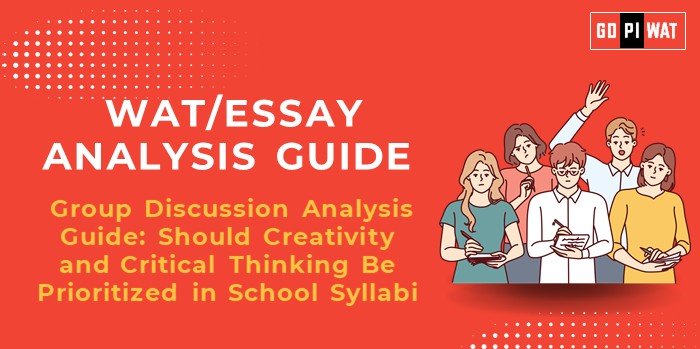📋 WAT/Essay Analysis Guide: Should Creativity and Critical Thinking Be Prioritized in School Syllabi?
🌟 Understanding the Importance of Creativity and Critical Thinking in Education
In a rapidly changing world, creativity and critical thinking are essential skills for success. Integrating these into school curricula prepares students for innovation-driven economies, enhances problem-solving abilities, and nurtures a workforce ready to face complex challenges. This focus also aligns with global education standards that emphasize skills over rote learning.
🕑 Effective Planning and Writing
- 📝 Time Allocation:
- Planning: 5 minutes
- Writing: 20 minutes
- Review: 5 minutes
- 💡 Preparation Tips: Use examples from countries like Finland and South Korea that emphasize creativity and skills-based learning. Highlight how critical thinking enhances employability and adaptability.
✍️ Introduction Techniques for Essays
- ⚖️ Contrast Approach: “While traditional education prioritizes memorization and grades, industries today demand creative problem-solvers and critical thinkers prepared for real-world challenges.”
- 🔧 Solution-Based Approach: “To prepare students for the future, integrating creativity and critical thinking into school curricula is not just beneficial but necessary.”
- 📅 Timeline Introduction: “Countries like Finland and Singapore have reformed their education systems to prioritize creativity, proving its positive impact on student outcomes and global competitiveness.”
🏆 Structuring the Essay Body
✅ Achievements
- 🧠 Enhanced Learning Outcomes: Schools integrating creativity report higher student engagement and improved problem-solving skills.
- 💡 Real-World Adaptability: Students with critical thinking abilities demonstrate resilience and better adaptability to dynamic workplaces.
- 🌍 Global Examples: Finland’s skills-based learning and South Korea’s shift towards critical thinking highlight the tangible benefits of prioritizing these skills.
⚠️ Challenges with Comparative Analysis
- 📚 Testing Systems: Standardized exams in India emphasize rote memorization, leaving little room to evaluate creativity.
- 🏫 Teacher Readiness: Educators often lack the training to implement interactive and skill-based teaching methods.
- 🌐 Global Comparisons: While countries like Finland thrive with holistic curricula, India’s large student population and diverse resources pose unique implementation challenges.
🚀 Future Outlook
- 🖥️ Hybrid Curricula: Combining foundational knowledge with creativity modules can achieve a balanced education.
- 🤝 Teacher Training Programs: Empowering teachers with innovative tools will ensure effective delivery of creativity-focused learning.
- 📊 Modern Assessments: Implement flexible assessments that evaluate analytical thinking and problem-solving abilities beyond factual recall.
🔚 Concluding Effectively
- ⚖️ Balanced Perspective: “While foundational learning is critical, integrating creativity and critical thinking will create well-rounded students prepared to succeed in modern economies.”
- 🌍 Global Comparison Conclusion: “Countries like Finland demonstrate that prioritizing skills-based learning fosters innovation, critical thinking, and personal growth—an approach India must adapt to remain competitive.”
📊 Analyzing Successes and Shortcomings
- ✅ Key Achievements:
- Increased student engagement and academic performance in creativity-focused schools.
- Promotes innovative thinking and collaborative skills needed in emerging industries.
- ⚠️ Ongoing Challenges:
- Rigid exam systems prioritize memorization over critical thinking.
- Teacher shortages and insufficient resources to support creativity-based learning.
- 🌍 Global Context:
- 🇫🇮 Finland: Focus on skills development and thematic learning creates adaptable students.
- 🇰🇷 South Korea: Transitioning from rote learning to critical thinking in modern classrooms.
🚀 Recommendations for Sustainable Progress
- 🤝 Hybrid Learning Models: Combine core subjects with creativity and critical thinking modules.
- 👩🏫 Teacher Development: Implement comprehensive training programs to equip educators with creative teaching methodologies.
- 📈 Modernized Assessments: Develop flexible evaluation systems to measure both analytical thinking and creativity.
✍️ Sample Short Essays
⚖️ Balanced Perspective
“While foundational knowledge remains essential, prioritizing creativity and critical thinking enables students to become adaptable problem-solvers, ready for the complexities of the modern world.”
🔧 Solution-Oriented
“To address the challenges of rote learning and industry skill gaps, schools must integrate creativity-focused modules and critical thinking exercises into the curriculum, ensuring holistic student development.”
🌍 Global Comparison
“Countries like Finland have successfully embedded skills-based learning into their systems, proving that fostering creativity and problem-solving enhances both academic outcomes and real-world readiness.”


